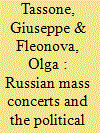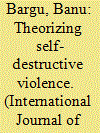| Srl | Item |
| 1 |
ID:
128663


|
|
|
|
|
| Publication |
2014.
|
| Summary/Abstract |
This article examines how possibilities for Muslim expression were and are shaped by the political imaginaries in Soviet-era and independent Uzbekistan. It develops the concept of social 'imaginary' in Charles Taylor's critique of Western secular modernity. Political imaginaries are the assumptions about the nature of being, the essential categories through which the world is understood and acted upon, that are produced within dominant state discourses and that shape the space for the political. The article compares the Soviet vision of socialist modernity and the logic of the current state ideology in independent Uzbekistan, and discusses how these have framed the possibilities for being Muslim. It argues that the category of culture is produced in distinct and contrasting ways in these imaginaries, and plays a central role in delineating the public space for Islam.
|
|
|
|
|
|
|
|
|
|
|
|
|
|
|
|
| 2 |
ID:
178074


|
|
|
|
|
| Summary/Abstract |
The article traces the transition from the Soviet to the post-Soviet Russian political imaginary as it unfolds at the site of state-sponsored Russian concerts. It contends that the idea of the Russian nation is being invented by translating the Soviet political imaginary, based on the logic of time, into a political imaginary based on the geography of space. The article shows that the political imaginary of Russia does not stand on its own, but is constantly injected with references to the Soviet past, thus generating ambivalence in the collective imagination of the Russian people.
|
|
|
|
|
|
|
|
|
|
|
|
|
|
|
|
| 3 |
ID:
124491


|
|
|
|
|
| Publication |
2013.
|
| Summary/Abstract |
The first image that the question of violence in the Middle East conjures up, especially in the West, is that of the suicide bomber. This association, etched into the political imaginary particularly over the course of the last two decades, is due neither to the number of victims suicide bombing creates (more conventional weapons of war can claim as many or more victims), nor to the identity of its victims (conventional weapons are also often directed at civilians). Rather, the potency of the image of the suicide bomber is connected to the simultaneously self-destructive and other-directed form that this act of violence takes. If the Orientalist impulse that has raised the image of the suicide bomber to iconic status is deeply problematic, it nonetheless constitutes an involuted acknowledgement of a reality: the significant rise in self-destructive violence (and not just in the Middle East). I have in mind practices such as hunger striking, self-immolation, and fatal self-mutilation, which constitute an emergent repertoire of struggle that has come to mark a certain current of radical politics around the globe. Those modalities of self-destructive violence that are not directed at others are overshadowed by suicide bombing.
|
|
|
|
|
|
|
|
|
|
|
|
|
|
|
|